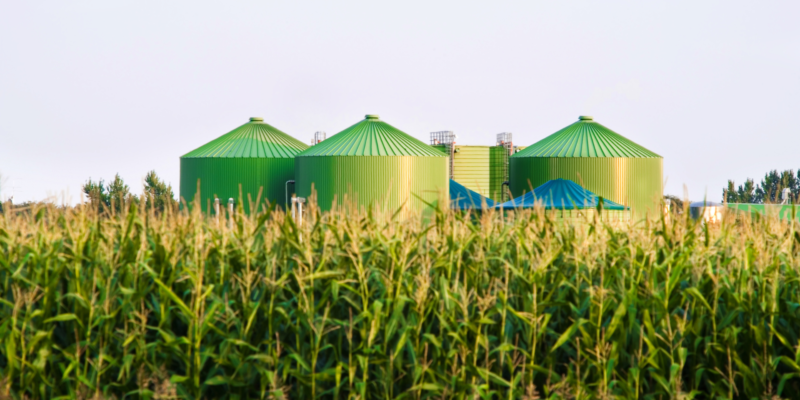Article 6 of the Paris Agreement at COP28: What is at stake?
Developing stringent rules for the global carbon market under A6.4 could set a precedent for high standards and restore faith…

Biogas is produced from the controlled decomposition of organic matter (through processes like anaerobic decomposition), where the gases that form as a result are captured. These gases are usually a mixture of methane (waste and agriculture account for roughly 60% of global methane emissions) and CO2, which are both potent greenhouse gases. Additional processes can be applied to remove the CO2 from biogas, leaving only methane, which is known as biomethane. For the purpose of this briefing, the term biogas is used to encompass both biogas and biomethane.
Biogas can be a substitute for current uses of fossil fuel-based natural gas, ranging from electricity generation to heating – the IEA estimates that biogas has the potential to replace 20% of current demand for natural gas. Some argue that by capturing methane from waste and agricultural products and using it as a substitute for natural gas, biogas is a necessary renewable solution for limiting global warming to 1.5oC. This briefing examines the potential and limitations of using biogas for reducing global emissions.
Agricultural byproducts are the main source of biogas feedstock today. However, biogas feedstock is not the only valuable use of agricultural byproducts. For example, animal waste can be used as fertiliser.
Biogas can reduce emissions in two ways:
Using biogas for electricity generation and heating still requires methane to be combusted, which produces CO2, the greenhouse gas driving climate change more than any other.
Therefore, the emissions benefit of biogas depend on:
It is also worth noting that common technologies for producing biogas from manure management (such as anaerobic digestion) tend to be inefficient and often produce large amounts of CO2, which require processing to upgrade into biogas.
Biogas’ potential to reduce agricultural emissions is limited to sources of emissions arising from manure and crop residuals, which contribute to a minority of agricultural emissions out of the five main sources:
Therefore, capturing emissions from manure and crop residuals to produce biogas will, at best, address 28.9% of global agricultural emissions, leaving the majority of emissions unabated. And this is likely to be an overestimate given that more than 80% of the world’s farms are held by smallholders in developing countries with less than two hectares of land that meet the technical and financial requirements needed to install an anaerobic digester. Comparatively, US livestock farms need to meet the following criteria to be potential candidates for anaerobic digestion:
Beyond using manure and crop residuals as sources of feedstock, biogas production requires farming energy crops, and this has been criticised by the IPCC for causing biodiversity loss, undermining food security and excessive water use, as well as creating the potential for temperature overshoot.
In the RePower EU plan, the European Commission announced a target of 35 billion cubic metres (bcm) of production volume in Europe by 2030. This is a twelvefold increase of the current 3 bcm biogas (specifically biomethane) produced in the EU each year.
An assessment by the Institute for Energy and Environmental Research (IFEU) for the European Climate Foundation of how much sustainable biogas could be produced in Europe found only 17 bcm could be produced by 2030.
It found that, in order to achieve the 35 bcm biomethane target, the residues available for biogas production would not be sufficient and a considerable amount of crop-based biomass would have to be used. This would have considerable disadvantages. In a realistic scenario, around five to six million hectares of arable land would be required. This equals 5% of the arable land and 20% of the land used for wheat cultivation in the EU27. It would be more than the area that is used in the Ukraine for rapeseed production. Occupying land for biomethane production would thus lower the land availability for food production significantly.
Most biogas produced today (64%) is used for electricity generation, predominantly in Europe and North America. Around 27% is used for heating in buildings. Acting as a substitute for fossil fuel natural gas can help avoid the current emissions impact of natural gas extraction, and its associated environmental impact. However, this substitution effect assumes that natural gas will continue to be used in electricity generation and heating. But viable alternatives such as renewable energy and widespread electrification already exist today. A study that evaluated the lifecycle environmental impacts of biogas electricity in comparison to other renewable alternatives looked at 11 environmental indicators (including emissions, human toxicity and ozone layer depletion) found that “biogas electricity can help reduce greenhouse gas (GHG) emissions relative to a fossil-intensive electricity mix; however, some other impacts increase. If mitigation of climate change is the main aim, other renewables have a greater potential to reduce GHG emissions.”
In fact renewable energy is now the cheapest source of energy in most countries. Given the continued cost reductions in wind and solar and high implementation cost of biogas production, it is unlikely that biogas electricity generation will be competitive against renewable energy on a levelised cost of electricity (LCOE) basis.
There may be a limited role for biogas as a substitute for fossil fuel-based natural gas for hard-to-abate sectors such as petrochemical production and industrial heat, where there are fewer options for electrification using renewable energy. However, achieving the volume and cost reductions needed to supply biogas for these purposes is by no means a given.
The IPCC has found that fugitive emissions generated by biogas plants can reduce the potential benefit of biogas production from an emissions perspective. A 2022 study found that supply chains for biomethane and biogas release more than twice the amount of methane previously estimated by the International Energy Agency, with 62% of leaks originating from a small number of facilities.
Another study examined 10 biogas plants in the UK and found that the rate of fugitive emissions reached a maximum of 9%, suggesting biogas plant methane emissions may account for up to 3.8% of total UK methane emissions. The research reached the conclusion that “the sustainability of biogas plants and the UK Net Zero Commitment may be jeopardised unless robust, consistent emission measurements and legal requirements are put into practice in the near future.”
Biogas production and consumption require significant investment for:
The cost of each component is highly dependent on the location of feedstock and its ultimate end use. This means biogas production tends to be more economically feasible in countries where the location of the feedstock is close to the source of final conversion and use, and where there is already transportation infrastructure in place. As a result, biogas production barely exists in countries like Australia, and remains challenging to implement in other regions (such as Latin America, Africa or Southeast Asia).
In Europe and the US, the high capital cost of installing biodigesters (around 70%-95% of total biogas costs) means significant subsidies are required to make projects financially feasible. A detailed geospatial analysis recently revealed that 40% of the amount that is technically available would still be uneconomic by 2050 without subsidies. In Germany, small plants have been found uneconomic, needing combinations of 50% of investment subsidised and EUR 11.50/MWh (USD 11.30/MWh) feed-in tariffs to make the projects economic.
The application of carbon capture and storage to limit the emissions of carbon dioxide when biogas is burnt at its end use would also increase costs significantly. Given alternatives that exist to reduce waste and agricultural emissions, and limited situations where biogas can be a credible substitute for hard-to-abate sectors, the public investment in biogas should be balanced against other investment opportunities in decarbonisation.
Many biogas facilities operate at small and medium scales, and they are not subject to the same safety standards as large-scale operations. Major hazards from biogas facilities include:
A study suggests that between 1994-2015, 169 accidents occurred in the biogas sector, 12% of which could be classified as serious. One hundred and sixty-three of these occurred in Europe, mostly in Germany, which has the highest number of biogas plants. Of these, 53% resulted in fire, 40% resulted in explosion and 7% were related to toxic release.
There are cost-effective alternatives for reducing emissions in agriculture and waste management that are ready for deployment. For example, transitioning to sustainable agriculture methods as well as a shift to a more sustainable food system are cost effective ways to reduce existing emissions in the agriculture industry. The IPCC found that economic mitigation options (less than USD 100 per tonne of CO2 reduced) such as improving soil management, agroforestry and livestock management have the mitigation potential of 4.1 GtCO2e each year. Shifting to sustainable healthy diets, reducing food waste and other demand side measures have the mitigation potential of 2.2 GtCO2e each year.

Developing stringent rules for the global carbon market under A6.4 could set a precedent for high standards and restore faith…

A handful of countries are setting up 'nature markets' for trading biodiversity offsets, but the concept could lead to greater…